Discover the perfect Lake Ontario camping escape along 1,020 kilometers of pristine shoreline, where crystal-clear waters meet untamed wilderness. From the rugged cliffs of Presqu’ile Provincial Park to the sandy beaches of Sandbanks, Lake Ontario’s shoreline campgrounds offer an unparalleled outdoor experience for both novice campers and seasoned adventurers. Choose from over 30 established campgrounds featuring everything from primitive tent sites nestled in pine forests to full-service RV parks with panoramic lake views.
What sets Lake Ontario campsites apart is their unique combination of natural beauty and accessibility – most locations sit within a two-hour drive from major cities like Toronto, yet offer the serenity of starlit nights and wilderness encounters. Whether you’re planning a weekend getaway or an extended summer vacation, these waterfront campgrounds provide the perfect base for swimming, fishing, hiking, and creating lasting memories against the backdrop of North America’s easternmost Great Lake.
Watch sailboats glide across the horizon from your beachfront site, explore historic lighthouses at sunset, or paddle along protected coves teeming with wildlife – Lake Ontario’s camping destinations promise adventures for every outdoor enthusiast.
Top Lake Ontario Provincial Park Campsites
Presqu’ile Provincial Park
Nestled on a stunning peninsula jutting into Lake Ontario, Presqu’ile Provincial Park offers some of the most scenic waterfront camping experiences in the region. With over 300 campsites spread across multiple campgrounds, nature enthusiasts can choose from electrical and non-electrical sites, many offering spectacular views of the shoreline.
The park’s Highland Campground is particularly popular among families, featuring spacious sites with easy access to modern comfort stations and laundry facilities. Beach lovers will appreciate the Maples and Lakeside campgrounds, where you’re just steps away from the park’s 2.5-kilometer sandy beach – perfect for swimming, sunbathing, and watching memorable Lake Ontario sunsets.
What sets Presqu’ile apart is its rich biodiversity. The park is a crucial stopover for migrating birds, making it a paradise for birdwatchers, especially during spring and fall migrations. Campers can explore eight nature trails, including a fascinating marsh boardwalk that winds through one of Lake Ontario’s largest wetland complexes.
Facilities include clean washrooms with hot showers, drinking water taps, and convenient dump stations for RVs. The park store stocks camping essentials, firewood, and ice, while the Nature Centre offers educational programs perfect for curious kids and adults alike.
Pro tip: Book sites in the Maples area if you want more privacy – these tend to have better tree coverage and natural separation between spots. For the best swimming experience, time your visit between mid-July and early September when the water is warmest.
Remember to reserve well in advance, especially for summer weekends and holidays, as Presqu’ile is a popular destination for both local campers and tourists from across Ontario.
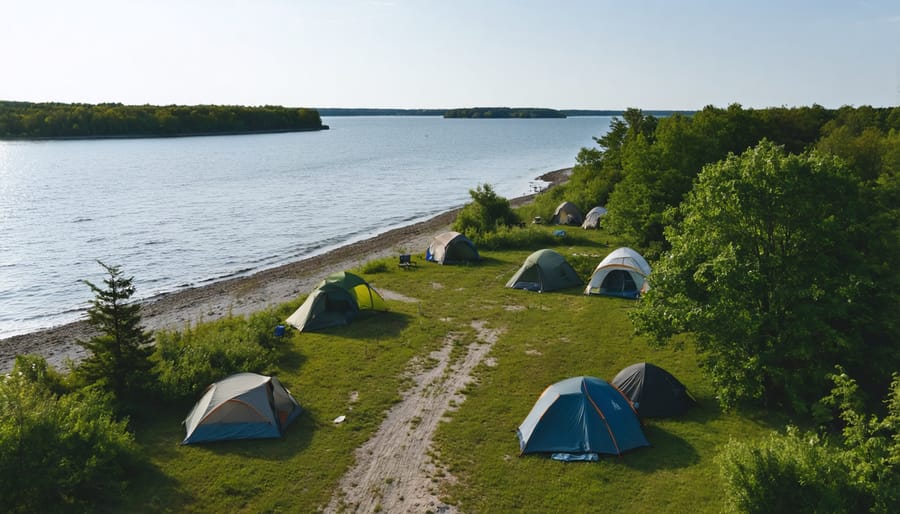
Sandbanks Provincial Park
Nestled along Lake Ontario’s northeastern shore, Sandbanks Provincial Park offers some of the most coveted beachfront camping experiences in Ontario. The park boasts three separate campgrounds – Cedars, Woodlands, and West Lake – with over 500 campsites total, many offering electrical hookups and easy beach access.
The park’s crown jewel is its stunning three-kilometer stretch of sandy beach, perfect for swimming, sunbathing, and building sandcastles with the kids. During peak summer months (July-August), securing a campsite can be challenging, so booking up to five months in advance through Ontario Parks’ reservation system is highly recommended.
For the best camping experience, try to snag a site in the Cedars campground, particularly in the 200-series sites. These spots offer more privacy and are just a short walk from the beach. The Woodlands area, while slightly further from the water, provides welcome shade on hot summer days.
Beyond beach activities, Sandbanks offers excellent opportunities for hiking, bird watching, and photography. The park’s unique dune system – the largest freshwater baymouth barrier dune formation in the world – creates a fascinating landscape to explore. Bring your bike to cruise the park’s cycling trails, or launch your canoe or kayak for a peaceful paddle on West Lake.
Pro tip: If you’re visiting during peak season, arrive early in the day to secure a good spot on the beach. The park can get quite busy, especially on weekends. Consider camping during shoulder seasons (May-June or September) for a quieter experience and better site availability.
Essential Planning Tips
Best Times to Visit
Lake Ontario’s camping season typically runs from May to October, with each period offering its unique charm and experiences. For the most comfortable camping conditions, plan your visit during the peak summer months of July and August, when temperatures hover between 20-25°C (68-77°F) and water activities are most enjoyable. Be sure to check our guide on seasonal camping gear essentials to pack appropriately for your trip.
Early birds will love the spring season (May-June), when campgrounds are less crowded and wildflowers paint the landscape in vibrant colors. Spring temperatures can be unpredictable, so pack layers and rain gear. Fall (September-October) offers spectacular foliage and comfortable daytime temperatures, perfect for hiking and photography enthusiasts.
For the best availability, book your campsite at least six months in advance for summer weekends and holidays. Mid-week stays typically have better availability and often come with reduced rates. The shoulder seasons (spring and fall) offer more flexibility with bookings and provide a more serene camping experience.
Pro tip: Consider visiting during the last two weeks of August when crowds start thinning out but the weather remains warm and perfect for swimming. September weekends can be particularly magical, with warm days, cool nights, and fewer mosquitoes to contend with.
Reservation Strategies
To secure your preferred campsite along Lake Ontario’s stunning shoreline, timing is everything. Ontario Parks accepts reservations up to five months in advance, and popular waterfront sites often get booked within minutes of becoming available.
Mark your calendar and set an alarm for 7:00 AM EST on your target booking date. Have your Ontario Parks account ready with payment information updated, and keep multiple dates flexible as a backup plan. Pro tip: Preview available sites beforehand and save your favorites to speed up the booking process.
For last-minute adventurers, check for cancellations regularly, especially 24-48 hours before your intended stay. Many campers cancel just before the deadline to avoid penalties, creating golden opportunities for spontaneous trips.
Consider shoulder seasons (May and September) when competition is lower but weather remains pleasant. These periods often offer the best chance of nabbing prime locations, particularly at popular parks like Presqu’ile and Sandbanks.
If you’re planning a group trip, designate multiple people to try booking simultaneously, increasing your chances of success. Remember to join Ontario Parks’ newsletter for updates about new site releases and booking system improvements. Some parks also offer first-come, first-served sites, perfect for flexible travelers willing to arrive early in the day.
Campsite Features and Amenities
Site Types and Services
Lake Ontario’s shoreline offers diverse camping experiences to suit every outdoor enthusiast’s preferences. From rustic tent sites nestled in wooded areas to full-service RV camping options with modern amenities, you’ll find the perfect spot to call home during your adventure.
Most provincial parks feature electrical hookups, clean comfort stations with hot showers, and well-maintained restroom facilities. Many campgrounds offer both serviced and unserviced sites, with the serviced ones typically including 30/50-amp electrical connections and water hookups. For tent campers, spacious sites come with level ground, picnic tables, and fire pits.
Group camping areas are available at select locations, perfect for family reunions or outdoor gatherings. These sites often include larger cooking areas and multiple tent pads. For those seeking a more secluded experience, backcountry sites accessed by hiking trails offer pristine natural settings with minimal amenities.
Additional services commonly found at Lake Ontario campgrounds include:
– Laundry facilities
– Camp stores for basic supplies
– Boat launches and fishing docks
– Playground areas for children
– Visitor centers with interpretive programs
– Potable water stations
– Dump stations for RVs
Pro tip: Book sites on the park’s outer loops for more privacy, or choose waterfront sites for stunning sunrise views over Lake Ontario.
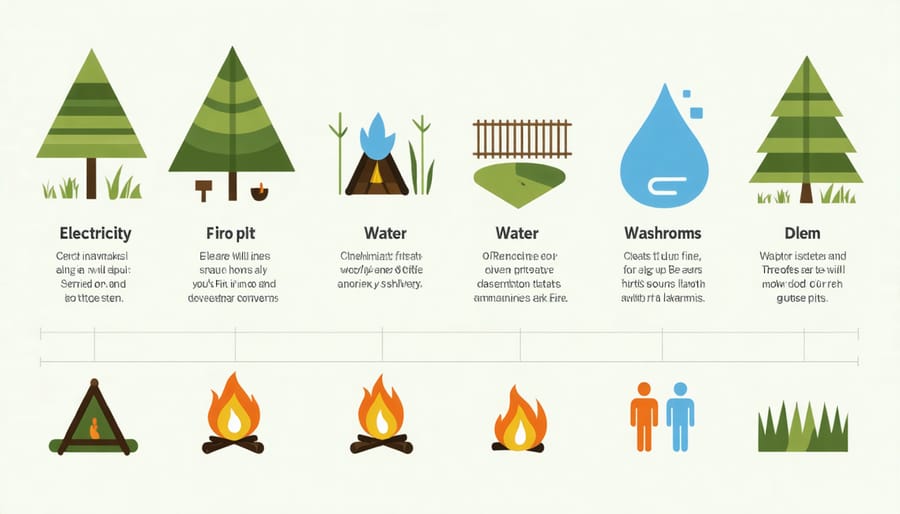
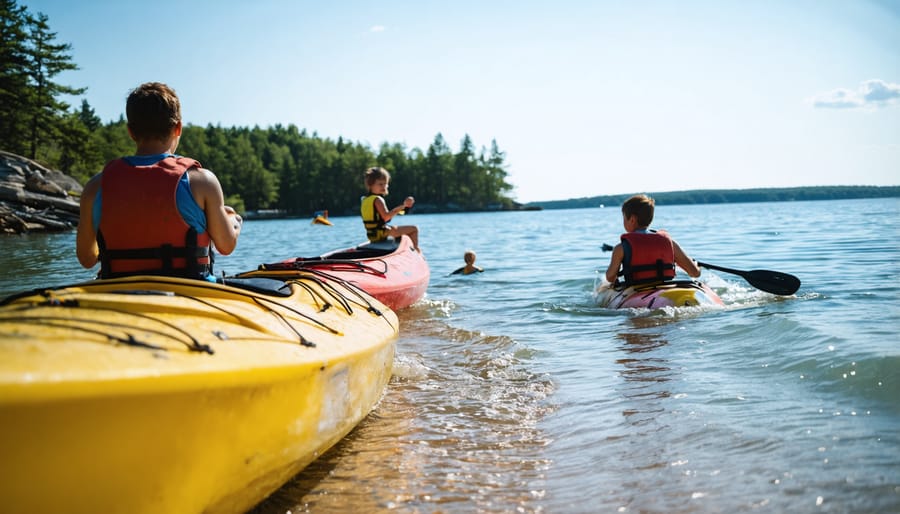
Waterfront Activities
Lake Ontario’s shoreline offers endless opportunities for water enthusiasts, making it a paradise for campers who love to splash, paddle, and fish. Many waterfront campsites provide direct access to sandy beaches where you can swim in the refreshing waters during hot summer days. The lake’s conditions are typically perfect for swimming from mid-June through early September.
For adventure seekers, kayaking and canoeing are popular activities, with several campgrounds offering equipment rentals right on-site. The calm morning waters are ideal for peaceful paddling, while afternoon breezes create perfect conditions for windsurfing and sailing. Experienced paddlers often enjoy exploring the countless coves and inlets along the shoreline.
Fishing enthusiasts will find themselves in heaven, as Lake Ontario is home to salmon, trout, bass, and pike. Many campsites feature fishing piers or boat launches, and some even offer guided fishing excursions. Remember to obtain your Ontario fishing license before casting your line.
Beach activities aren’t limited to swimming – build sandcastles, hunt for beach glass, or simply relax with a good book while watching stunning lake sunsets. For nature lovers, the shoreline provides excellent opportunities for bird watching, especially during migration seasons.
Eco-friendly tip: When enjoying water activities, use biodegradable sunscreen to protect both your skin and the lake’s ecosystem. Also, remember to pack out what you pack in to keep these beautiful shores pristine for future campers.
Conservation and Safety Guidelines
Environmental Stewardship
When camping along Lake Ontario’s pristine shores, it’s crucial to embrace eco-friendly camping practices to preserve these natural spaces for future generations. Always pack out what you pack in, and bring reusable containers instead of disposable ones. Keep your campsite clean by storing food properly to avoid attracting wildlife, and use designated fire pits only.
Stick to marked trails to protect sensitive vegetation and prevent erosion along the shoreline. When collecting firewood, gather only dead and fallen branches from the ground, never cut live trees or strip bark. Use biodegradable soap for washing and always do so at least 200 feet away from the lake and streams.
Consider bringing a portable solar charger instead of disposable batteries, and use LED lanterns to minimize energy consumption. Before leaving your site, conduct a thorough sweep to ensure no trash remains, and consider picking up any litter you find along the way. Remember, even small actions like using a refillable water bottle instead of plastic ones can make a significant difference in protecting Lake Ontario’s delicate ecosystem.
Water Safety
Lake Ontario’s pristine waters are inviting, but safety should always come first when camping along its shores. Always check the weather forecast before swimming or boating, as conditions can change quickly on this vast lake. Keep an eye out for posted warning flags at designated swimming areas – red means stay out of the water, while green indicates safe conditions.
Never swim alone, and ensure children are supervised at all times. It’s best to stick to designated swimming areas where possible, as these spots are regularly monitored and maintained. If you’re planning water activities, wear properly fitted life jackets – they’re not just for boating!
Watch out for rip currents, which can occur even on calm days. If caught in one, remember to swim parallel to the shore until you’re free from the current. Keep a safe distance from rocky areas, especially during rough weather when waves can be unpredictable.
During evening hours, avoid water activities as visibility is limited. Always have a whistle or other signaling device handy for emergencies, and familiarize yourself with the location of emergency phones and first aid stations at your campsite.
Remember, drinking water directly from the lake isn’t safe – always use designated drinking water sources at your campground.
Lake Ontario’s shoreline offers some of the most memorable camping experiences in Ontario, with each site bringing its own unique charm and natural beauty. Whether you choose the sandy beaches of Sandbanks, the historic atmosphere of Presqu’ile, or the serene settings of Fair Haven Beach State Park, you’re in for an unforgettable outdoor adventure.
Remember to book your campsite well in advance, especially during peak summer months from June to September. Pack appropriate gear for varying weather conditions, as Lake Ontario can bring unexpected changes. Don’t forget essentials like sunscreen, insect repellent, and plenty of drinking water.
For the best experience, try to visit during shoulder seasons (May-June or September-October) when the crowds are thinner and the weather is still pleasant. Consider bringing along water shoes for rocky beaches and a good camera to capture stunning lakeside sunsets.
Make the most of your stay by participating in park programs, exploring hiking trails, and taking advantage of water activities. Many campsites offer excellent fishing opportunities, so pack your gear if you’re interested in catching some local species.
Most importantly, practice Leave No Trace principles to help preserve these beautiful camping spots for future generations. Pack out what you pack in, respect wildlife, and follow fire safety guidelines. With proper planning and respect for nature, your Lake Ontario camping adventure will be one for the books.






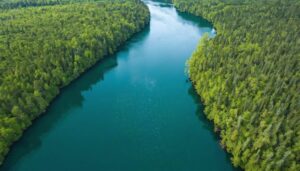


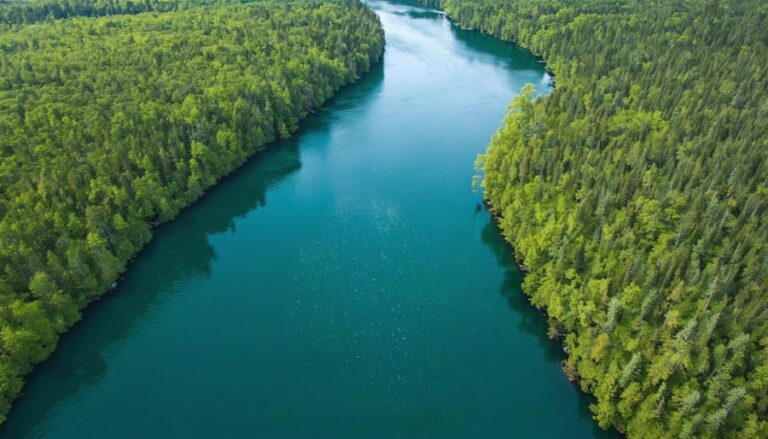




+ There are no comments
Add yours